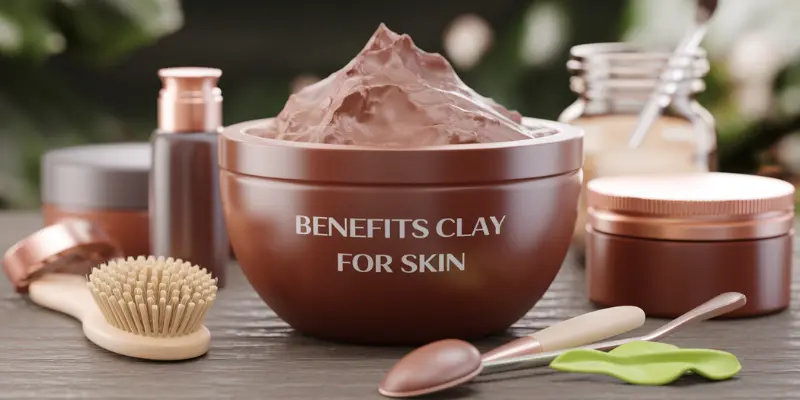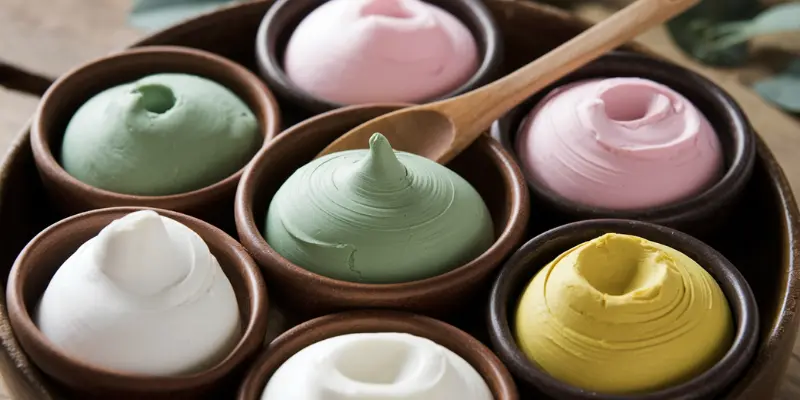The Ultimate Guide to Clay for Skin: Benefits, Types, & Tips
Published: 27 Feb 2025
Clay is a natural material made from finely ground minerals. It has been used in skincare for centuries due to its cleansing and detoxifying properties. Ancient cultures trusted clay to heal and improve skin health.
Today, clay remains a popular ingredient in skincare products. It helps absorb excess oil and remove impurities, which is great for those people struggling with acne, oily skin, or dullness. In this blog, we’ll cover the benefits, uses, types, and side effects of clay for skin.
Benefits of Clay for Skin

Clay is an incredible natural ingredient for your skin. It can deeply cleanse, balance, and rejuvenate your skin. Here’s how it works and what it can do for you!
Cleanses and Detoxifies
- Clay has strong adsorptive properties, meaning it can attract and pull impurities, toxins, and dirt from your skin.
- This detox effect helps to purify your pores, leaving your skin feeling fresh and clean.
- It works especially well for people with congested or dull skin, removing the buildup of excess oils, dead skin cells, and environmental pollutants.
Absorbs Excess Oil
- Clay naturally absorbs sebum (the oil your skin produces) due to its fine particle structure.
- It helps balance oily skin, preventing that greasy shine that many people with oily skin struggle with.
- By controlling oil production, clay helps prevent clogged pores, which are often a key cause of acne and breakouts.
Improves Skin Texture
- The fine minerals in clay help to exfoliate and smooth the skin’s surface by removing dead skin cells.
- It also enhances skin renewal, making your skin feel softer and more even-toned.
- Regular use can lead to smoother skin that feels refreshed and looks more radiant.
Reduces Acne and Pores
- Clay works to clear clogged pores, reducing the buildup of dirt and oil that leads to acne.
- It helps shrink pores by absorbing impurities and preventing them from expanding.
- By keeping your pores clear, clay also reduces the chances of future breakouts, leaving your skin smoother and more refined.
Rejuvenates Dull Skin
- The detoxifying effects of clay can help rejuvenate tired and dull skin by increasing blood circulation and promoting healthier skin cell turnover.
- By removing impurities, it helps brighten your complexion and give your skin a healthy, radiant glow.
- Clay masks can also improve the skin’s natural moisture barrier, making your skin look plumper and more youthful.
Types of Clay

Each type of clay is made from different minerals and has its own specific properties that make it ideal for different skin types. Let’s explore the types of clay and their characteristics.
Bentonite Clay
Bentonite clay is a volcanic ash clay, primarily composed of minerals like montmorillonite. It has a high cation exchange capacity, which means it can absorb and pull toxins, oils, and impurities from the skin. This makes it particularly effective for oily skin.
Kaolin Clay
Kaolin clay, also known as china clay, is a kaolinite mineral. It’s one of the softest clays, with a low pH that is ideal for sensitive skin. It’s often used in products for its mild, non-irritating properties.
Rose Clay
Rose clay is a blend of red and white clays and contains minerals like silica and kaolinite. It’s known for its gentle, soothing nature and is ideal for those needing a soft cleanse. It has a neutral pH that helps hydrate the skin.
Green Clay
Green clay is made from a mix of iron oxide and other mineral-rich clays, such as illite. This gives it a high absorption capacity, helping to draw out excess oils while also providing minerals to the skin. It’s often used for combination skin.
Pink Clay
Pink clay is a combination of red clay and white clay. The iron oxide in pink clay provides a gentle but effective cleansing action, while the white clay adds a softening effect. It’s perfect for sensitive or mature skin that needs a gentle touch.
How to Use Clay for Skin care

Using clay for skin care is easy, and it can make a big difference in how your skin looks and feels. Here’s how you can use clay for skin like face masks, spot treatments, body masks, and hair care.
Clay Face Masks
- Start with clean skin. Wash your face with a gentle cleanser.
- Mix the clay with water (or a little rose water for extra hydration) to make a smooth paste.
- Apply the paste evenly to your face, avoiding the eye area.
- Leave it on for 10-15 minutes until it dries.
- Rinse off with warm water, gently massaging your skin in circular motions.
Body and Foot Masks
- Mix the clay with water to form a paste.
- Apply it to areas like your back, arms, or feet.
- Leave the mask on for 10-15 minutes or until it dries.
- Rinse it off with warm water, using a washcloth if needed for extra exfoliation.
Spot Treatment for Acne
- Mix a small amount of clay with water to make a thick paste.
- Dab the paste directly onto the acne spots.
- Let it sit for 10-15 minutes before rinsing off with water.
- Repeat this treatment as needed until the acne begins to heal.
Hair Masks
- Mix the clay with water to make a paste.
- Apply it to your scalp, focusing on the roots and areas where you have buildup.
- Leave it on for about 15-20 minutes.
- Rinse off thoroughly, then shampoo and condition as usual.
Side Effects of Clay for Skin
While clay is great for the skin, it’s important to know that it can cause side effects for some people, especially if it’s used too often or not suited to your skin type. Let’s go over a few side effects of clay for skin you should be aware of.
Dryness
Some types of clay, like bentonite, can be very drying. If you have dry skin, using clay too often may leave your skin feeling tight, flaky, or rough. It’s important to balance your clay use with moisturizing products to keep your skin hydrated.
Irritation
In some cases, clay can cause irritation, especially if you leave the mask on for too long. You may notice redness, itching, or a slight burning sensation. If this happens, remove the mask immediately and avoid using it for a while.
Not Suitable for All Skin Types
- Oily Skin: While clay is great for absorbing excess oil, using it too often can strip your skin of its natural oils, leading to an imbalance.
- Dry Skin: Strong, drying clays like bentonite should be used carefully. They may worsen dryness, so it’s best to use them sparingly.
- Sensitive Skin: Some types of clay, like green clay, can be too harsh for sensitive skin and might cause redness or irritation. It’s better to use gentler options, like kaolin clay, for sensitive skin.
FAQs
1. Is clay good for the skin?
Yes, clay is great for the skin because it helps absorb excess oil, remove impurities, and detoxify the skin. It also helps improve skin texture and reduce acne. However, it’s important to choose the right type of clay for your skin type.
2. Which clay is the best for skin?
The best clay depends on your skin type. For oily skin, bentonite clay works well, while kaolin clay is great for sensitive skin. Rose clay is perfect for dry skin, and green clay suits combination skin.
3. What is the difference between red and green clay?
Red clay is rich in iron and is great for sensitive or dry skin, offering soothing properties. Green clay, on the other hand, is more absorbent and helps with oily skin by drawing out excess oils and impurities. Both clays have their unique benefits, but they cater to different skin needs.
4. Can I put clay on my face?
Yes, you can apply clay masks on your face. Just make sure to follow the instructions and leave the mask on for the recommended time. Always do a patch test first if you have sensitive skin to avoid irritation.
5. How often should I use clay on my skin?
Using clay once a week is generally good for most skin types. If you have oily skin, you can use it more often, but for dry or sensitive skin, limit the use to avoid dryness or irritation. Always listen to your skin and adjust the frequency based on how it reacts.
Conclusion
So guys, in this article, we’ve covered clay for skin in detail, discussing its many benefits like oil absorption, detoxification, and improving skin texture. Clay can help with acne, dull skin, and even give your skin a healthy glow. But remember, it’s important to choose the right type of clay based on your skin type, whether you have oily, dry, or sensitive skin.
Moderation is key when using clay for skin. While it offers great benefits, using it too often can cause dryness or irritation, especially for sensitive skin types. Always do a patch test before applying any clay mask to your face, and listen to your skin’s needs to get the best results.

- Be Respectful
- Stay Relevant
- Stay Positive
- True Feedback
- Encourage Discussion
- Avoid Spamming
- No Fake News
- Don't Copy-Paste
- No Personal Attacks

- Be Respectful
- Stay Relevant
- Stay Positive
- True Feedback
- Encourage Discussion
- Avoid Spamming
- No Fake News
- Don't Copy-Paste
- No Personal Attacks






